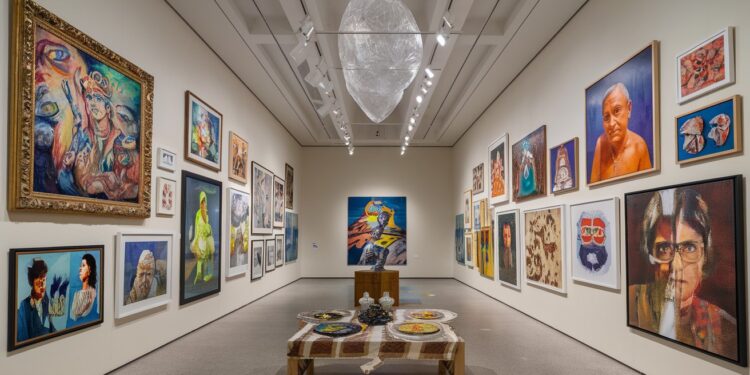A groundbreaking exhibition at the Barbican Centre in London is captivating audiences with its powerful showcase of Indian art created during a pivotal period of national soul-searching and transformation. The Imaginary Institution of India brings together works by 30 visionary artists grappling with their country’s tumultuous trajectory between 1975-1998, an era bookended by events that shook the foundations of India’s post-colonial democracy.
The exhibition, whose title is borrowed from an essay by political scientist Sudipta Kaviraj, posits the audacious idea of nation-building as a fundamentally creative act – one that summons the imaginative energies of a society’s artists and intellectuals, not just its political and bureaucratic architects. Unfolding chronologically through impeccably curated galleries, the show reveals Indian artists as chroniclers of civilizational upheaval, celebrants of resilient love and joy, and dreamers of alternative futures.
Unflinching Portrayals of Brutality and Bureaucracy
Many works confront the exhibition’s visitors with bracing visions of state violence and dehumanization. Rameshwar Broota’s monumental Reconstruction (1977) imagines a purgatory of suited, numbered, and largely faceless beings – disturbingly ape-like – awaiting an ominous fate beneath a web of colored wires. In a harrowing painting from 1989, MF Husain renders the slain body of street theater activist Safdar Hashmi dangling starkly from a tree, his hollowed eyes replaced by slashes of red.
“It’s a bruising encounter with a time of existential crisis in India’s journey as an independent nation, and a humbling testament to the valiant artists who bore witness and held onto their ideals in the face of turmoil.”
– Exhibition Curator
Death stalks the exhibition in other guises: Gieve Patel’s Battered Body in Landscape (1993) melds a decomposing corpse into a mottled hillside, while Sheela Gowda’s Mortar Line (1996), sculpted in cow dung, evokes a bleeding gash in the earth itself. The mood is not unrelentingly grim, however. Poetic works capturing the small epiphanies of everyday life remind us of the persistence of humane values even in harsh times.
Glimmers of Love, Community and Mythic Imagination
Bhupen Khakar’s luminous Two Men in Benares (1982) enshrines the embrace of lovers in the holy city of Varanasi, their ardor simultaneously transcending and belonging to the rituals of the Ganges. In photographic essays by Pablo Bartholomew, we glimpse Indian youth immersed in private raptures during the Emergency period of 1975-77 – dancing, hanging out, lost in conversation and intimacy.
Suresh Jayaram’s nostalgic mixed-media works on the vanishing professions of Bangalore pay homage to the unsung men and women who breathed life into India’s modernizing cities. And some of the show’s most captivating pieces revel in otherworldly enchantment, like Nilima Sheikh’s mobile painted pavilion Shamiana (1996), which unfolds a mythopoetic universe of female experience in folk-inflected hues.
The Necessity of Indigenous Visions
A recurring theme is the growing recognition by Indian artists of this period that the wisdom and artistry of the country’s indigenous communities offered vital alternatives to Western-centric paradigms of progress. Jangarh Singh Shyam, championed by the visionary critic Jagdish Swaminathan, reanimates the ancestral spirits and origin stories of the Pardhan people in intricate, mesmerizing drawings.
The show’s profound seriousness of purpose never precludes flashes of joy, sensuality, and humor. It memorably concludes with Bhupen Khakhar’s Grey Blanket (1998), a tender depiction of an aging gay couple’s love, and a moving bookend to Khakhar’s youthful lovers of nearly two decades prior. It’s a poignant affirmation of art’s capacity to bear witness to both convulsive change and human constancy.
As visitors exit the galleries, they are left reflecting on the potency of the imagination as a tool of resistance, resilience, and civic participation. The Imaginary Institution of India not only illuminates a pivotal chapter in India’s modern art history, but highlights the enduring role artists play in constructing a nation’s sense of itself – its traumas and triumphs, its myths and countermyths, its unresolved contradictions and its possible futures.








